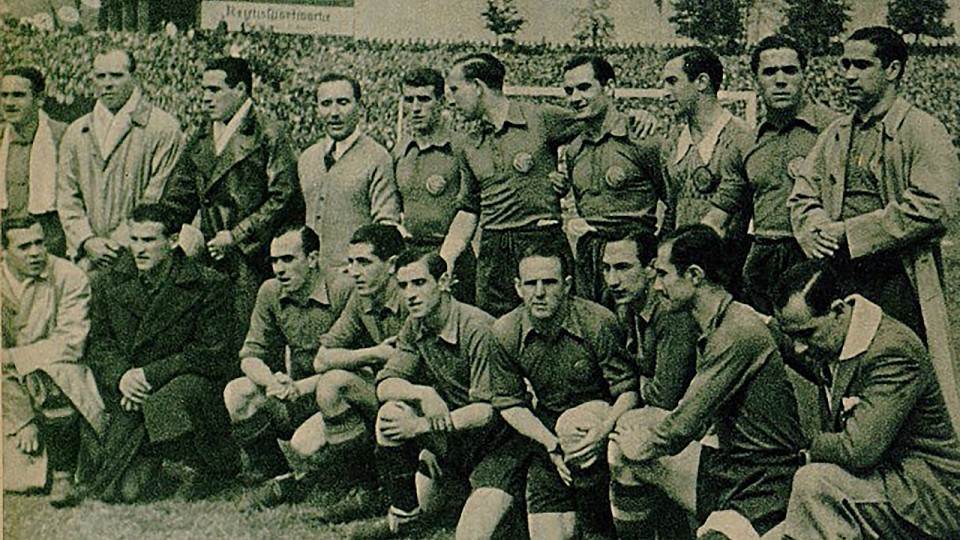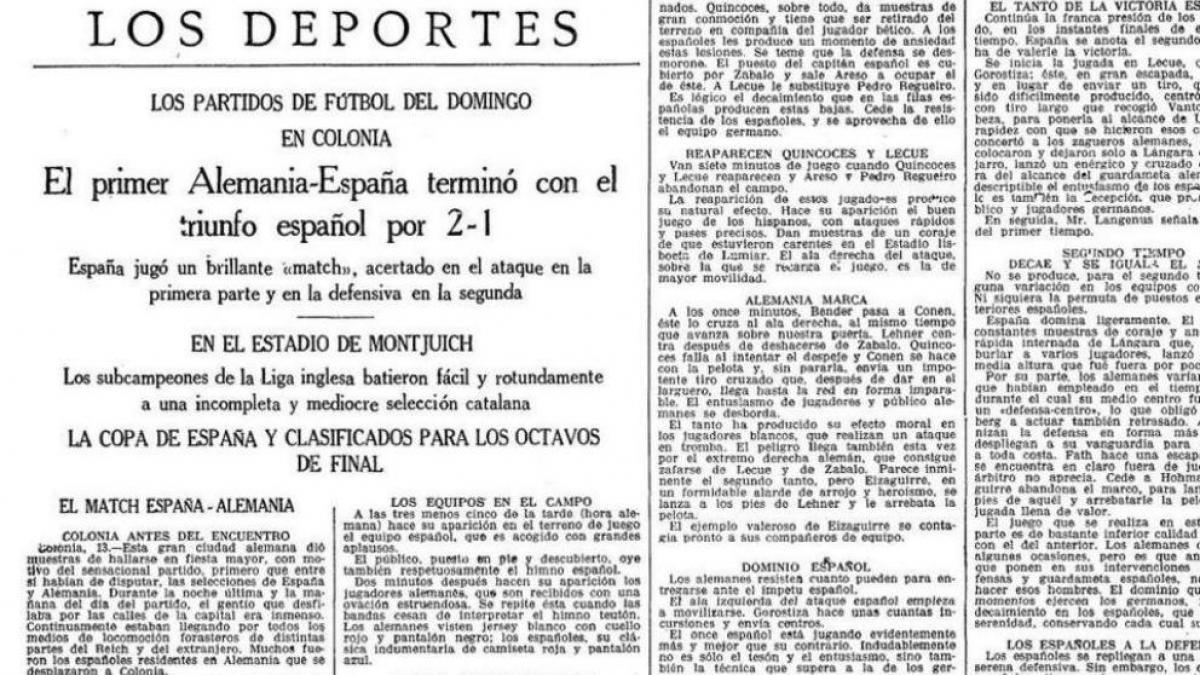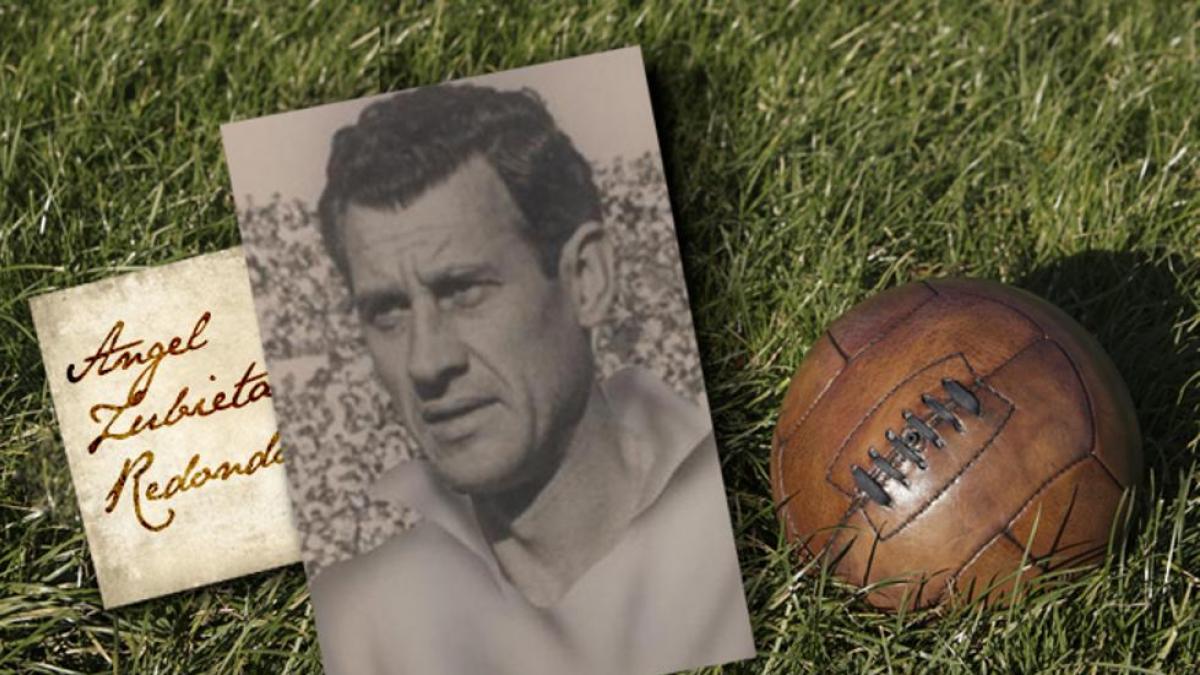History of the National Team (Part 6): The National Team in the lead up to the Civil War (1934-36)

After the bittersweet feelings following the 1934 World Cup, Spain then went through a two-year period (1935 and 1936) full of great victories, as well as the odd setback, before the Civil War brought everything to a standstill. Of all those matches before the war, one in particular stands out: the one played in 1935 when the Spanish national team travelled to Adolf Hitler's Germany to play a friendly match against the German team.
Before travelling to Germany, the team played two matches in 1935, beating France and drawing 3-3 with Portugal.
In Chamartín (Madrid), in January, the national team defeated the French by 2 goals to nil, with goals from Regueiro and Hilario. García Salazar used the same core of players from the previous World Cup for this match. The national team, who had been training in El Escorial and had defeated a touring team from Budapest 7-4 in a training match, relied on the security provided by Zamora in goal, the defensive awareness and solidity of Cilaurren and the goal scoring prowess of the attacking quintet from which, on this occasion, Luis Regueiro shone.
Against Portugal in May, García Salazar introduced significant changes: Guillermo Eizaguirre played in goal instead of Zamora. Quincoces' defensive partner was Areso (Betis), who had already made his debut in the previous match against France. In midfield, the undisputed starter Cilaurren and the increasingly important Simón Lecue, who would go on to win seven caps, continued in the centre of the park. The coach experimented with the debutant Soladrero in central midfield (Oviedo), this would prove to be his only international cap. Up front, the big change was the return of Ventolrá on the right accompanied by mainstays Luis Regueiro, Lángara, Iraragorri and Gorostiza.
The team drew 3-3, with goals from Ventolrá, Lángara and Gorostiza. The result culminated in a bad look for the national team, an image which was compounded one evening with an ugly incident in a Lisbon cabaret when Gorostiza and Casuco (Oviedo) got into a fight. The latter, who started the incident, was sent home from the squad that would travel to Germany.
1-2 victory over Nazi Germany
The match against the Germans took place on 12 May 1935 in the city of Cologne.
German captain Conen gave the home side an early lead, but two goals by Isidro Lángara before half-time handed the victory to Amadeo García Salazar's Spain team.
Some 80,000 spectators watched the match, in what was the first ever encounter between the Germans and Spaniards. The political atmosphere in the central European country at the height of the Nazi regime came to the fore. Something La Vanguardia newspaper underlined when it wrote that "German nationalism was overflowing. Sensational importance was attached to this struggle'. As evidence of the aforementioned claim, five days later, the Catalan newspaper published an illustrated supplement with 13 photos of the clash. One of the images shows how, when the Spanish team took the field, the Germans formed a corridor with their one-handed salutes clearly visible for all to see.
Spain, on this occasion, not only won but also impressed with their style of play, one which gave them a deserved victory. The great image of Spanish football from the Italian World Cup the previous year extended into 1935. A particularly pleasing aspect was the large Spanish presence in the stadium, as reported in the newspaper ABC.
Eduardo Teus, in the daily newspaper El Sol, preferred to focus on how Spain had exposed the weaknesses of their opponents’ tactical system. Used by the Germans was the emerging WM formation, which was becoming increasingly common.
"It's really nothing new. The German coach, Dr. Nerz has adopted it from the one used in England by most club teams. It's a good tactic when the pitches are soft and heavy from rain, but impractical on well-manicured grass pitches like the one in Cologne, which was hardened by dry weather. In those conditions, with a fast team in front of them, there is a risk of leaving too big a gap in the centre of the pitch, despite dropping the inside forwards back, it made it easier for the opposition to attack freely and create danger. Against us it was not just a France style mad Latin fury that they had to overcome. Spain’s passion was complemented by excellent technique".
In a well-known newspaper of the day, the future national team coach Eduardo Teus, with his astute way with words, defined and detailed the style of play of that Spanish team of the 1930s. A team that based its play on speed and "few short passes and no dribbling. It outsmarted the Germans, switching the ball quickly and using long passes that baffled the Germans". In what was an outpouring of both Spanish "fury" and brains "There was thinking. It wasn't all passion". It was clear to all they were not just eleven individuals, "Spain gave the impression of a complete team. When attacking, because of the depth and agility of their football, and when defending, because of the serene, conscious and orderly way in which they dealt with danger".
In contrast to 1935, in 1936 the national team were left with a sour taste in their mouths in all the matches they played. They suffered their first home defeat in their history when they lost to Austria in January. Pedro Escartín, who acted as linesman in this match, summed up what happened, putting it down to "chaos in Spain's defensive line and tremendous confusion on the part of Eizaguirre".
Then came the second home defeat, this time against Germany in February. It was a match that could not escape the atmosphere of political tension in Spain. The encounter was played on 23 February, at the same time as the elections of that year were being held (on 14 and 23 February). The poll saw the left-wing coalition of the Popular Front emerge victorious.
Simón Lecue would recall years later in Marca (Sports newspaper) the tension surrounding that match:
"When the teams were ready to go out onto the pitch they came to tell us that the brass band did not want to play the German anthem. Of course, our opponents protested and even refused to take to the field. The whole thing was quite unpleasant and violent, and in the end we managed to get the two teams to go out together and neither national anthem was played. We made do with a few chants in the middle of the pitch".
Spain then embarked on a tour of Europe, losing 1-0 to Czechoslovakia and recording their only win of the year (2-0) against Switzerland in Bern.
1935-36 was a period of numerous changes in the national team, which was entering a period of transition. Zamora's imminent departure was on the cards but the Spanish goalkeeper Guillermo Eizaguirre’s poor performance against Austria resulted in him being dropped from the squad. As such, Athletic goalkeeper Gregorio Blasco, who was in goal in Prague and Berne, worked to consolidate his position in goal. Likewise, the defensive pairing of Ciriaco and Quincoces gradually disappeared from the line-ups while a new duo emerged, Serafín Aedo (Betis) and Ramón Zabalo (Culé). This new back line was to become one of the most effective of the year 1936, with magnificent performances not only against Czechoslovakia where the defenders put in what was called an "invaluable performance by the whole Spanish defence", according to As sports magazine. Furthermore, they put in a shift against Switzerland when the "Blasco-Zabalo-Aedo” trio at the back was at their “most solid". (As sports magazine)
Muguerza dominated the centre midfield and was an almost ever-present, but he had numerous partners alongside him. Among these was the appearance of Ángel Zubieta who became the youngest player to make his debut for the national team (at the age of just 17). A record that lasted until 2021, when it was surpassed by Gavi. The youngster’s debut was at the Letna stadium in Prague on 24 April 1936, when he was only 17 years and 284 days old. However, he only had the opportunity to play one more international match, against Switzerland, in Bern, in May 1936.
The forward line had permanent fixtures on the right in the shape of Ventolrá and Luis Regueiro, as well as the irreplaceable centre forward, Lángara. Between Regueiro and Lángara they scored six goals in 1936, three each. On the left wing there were more changes: Gorostiza, who was accused of being past it and no longer being the mythical "red bullet", saw competition from Emilín (Madrid), while Iraragorri and Lecue competed for the inside left position.
Truncated proposals
In order to try to alleviate the problems that the national team was experiencing and which had become evident in 1936, García Salazar set to work on two solutions.
Firstly, he was willing to put pressure on the clubs to release players to him without putting up so many obstacles; against Czechoslovakia and Switzerland, the coach was unable to call up Marculeta or Gabilondo due to the lack of cooperation from their club teams.
In addition, more friendly matches began to be negotiated in order to strengthen the players' understanding and the team's play. There was a very ambitious agenda in the pipeline: they hoped to host Czechoslovakia and Switzerland, play England and travel to Austria and Hungary.
However, there would no longer be time to put such plans into practice. The matches against the Czechs and Swiss became the last National team matches that Spain would see before the start of the Civil War that tore Spain apart, divided Spaniards and buried the first stage in the history of the Spanish national football team.

